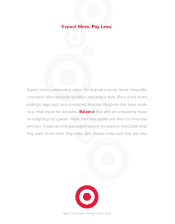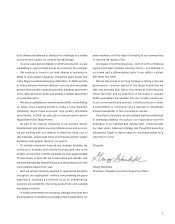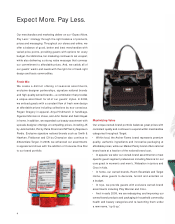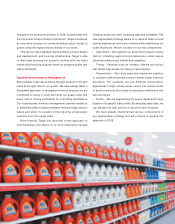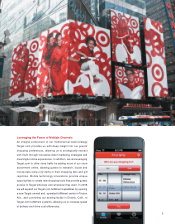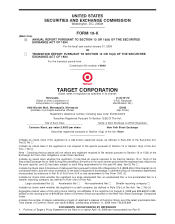Target 2008 Annual Report Download - page 9
Download and view the complete annual report
Please find page 9 of the 2008 Target annual report below. You can navigate through the pages in the report by either clicking on the pages listed below, or by using the keyword search tool below to find specific information within the annual report.
throughout the production process. In 2008, in partnership with
the Consumer Product Safety Commission, Target introduced
an innovative process for communicating product recalls to
guests using the registry kiosks already in our stores.
Through our fully integrated merchandising, product design
and development, and sourcing infrastructure, Target is able
to effectively increase our speed to market with the latest
trends while ensuring products meet our stringent quality and
safety standards.
Sophisticated Inventory Management
Being reliable is also about having the right product in the right
place at the right time for our guests. We have always taken a
disciplined approach to managing inventory because we are
committed to being in stock with what our guests want and
need, and to driving profitability by controlling markdowns.
Our sophisticated inventory management systems enable us
to effectively strike a balance between having enough product
where and when it’s needed, while reducing unnecessary
inventory from the supply chain.
More recently, Target has launched a new approach to
merchandising that allows us to more effectively manage
inventory across the chain, increasing sales and profitability. This
new segmentation strategy allows us to respond better to local
market preferences and store volumes while maintaining our
scale efficiencies. We are focused on four key components:
• Assortment – We segment our assortment based on many
factors, including regional food preferences, urban versus
suburban markets and market demographics.
• Timing – Variables such as holidays, climate and school
start dates help dictate the timing of assortments.
• Presentation – We study sales and markdown patterns
to optimize shelf presentation and to deliver better inventory
allocation. For example, we use different presentation
approaches in high-volume stores versus low-volume stores
to avoid overstocks that create unnecessary markdowns and
store workload.
• Space – We are segmenting the space inside each store
based on its specific sales profile. By analyzing sales data, we
can allocate the right amount of space to each business.
We have already implemented various components of
our segmentation strategy and will continue to expand this
approach in 2009.

